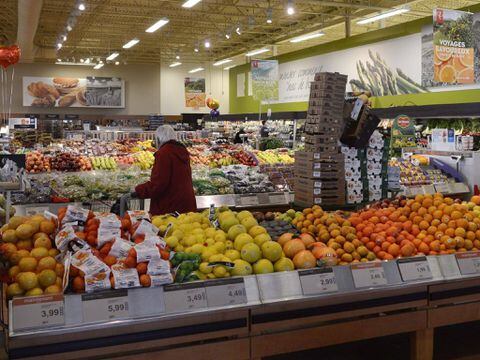Symmetrical Perfection
"We can't sell our misshapen cucumbers even though they taste exactly the same and are just as nutritious as what you'd call a 'grade 1' cucumber."
"No one wants to buy an ugly cucumber so we usually just end up composting them, or occasionally selling them for half price if we can find a buyer."
Organic farmer, Brent Preston
 |
A
shopper is seen in a Loblaws produce section in Montreal. Ugly food can mean a pretty profit. At least, that's the
bet Loblaw is making with a nearly national expansion of its ugly
duckling produce line that's been appealing to shoppers looking to save
money on sky-rocketing fresh food prices.
Ryan Remiorz/THE CANADIAN PRESS
|
In breeding produce for enhanced appearance other attributes often suffer; for example, taste.
Heritage seeds that grow vegetable and fruit types no longer popular often tasted better but didn't stay fresh as long, and when ripe didn't have that kind of perfect look consumers now expect in the produce they buy. Taste, texture and flavourful aroma may have been lost in the process of teaching produce to be on their best visual behavior, but this is what consumers have been led to believe is the clue to their freshness and good taste, belying reality.
If it looks good, it must be good. If it looks bent out of whack it can't possibly be good.
On the outskirts of Etobicoke, Ontario (which is part of greater Metro Toronto) Canada's largest wholesale fruit and produce terminal, The Food Terminal, represents the conduit from farm to retail. Daily, 5.5 million pounds of produce brought to the market becomes distributed throughout Eastern Canada and the Northern United States. At three in the morning sharp, produce begins arriving at the terminal.
 |
Unsightly scars on the outside of fruit might reflect higher nutrition within.
|
And then begins the sorting hierarchy where good-looking vegetables are approved for "grade 1" labelling and their contorted counterparts are given a lower ranking as "grade 2". Perfect-in-appearance apples, for example, are graded "Fancy" and "Extra Fancy". Cantaloupes appearing lopsided rather than perfectly spherical with just-right appearing skin doesn't even make the grade as saleable.
Produce of equal dimensions and attractive colouration is carefully loaded into crates for shipment to supermarkets across the country, and in contrast the "cosmetically challenged" may be sold at discount prices to be processed into canned goods, given away to food banks or simply tossed out as nuisance products no one wants. They don't make the grade of presentation and are rated to have no place on store shelves.
There is a generally shared legend that whatever looks appreciably attractive has all the nutritious and taste elements down pat; all others need not apply. If the best looking fruits and vegetables are those that consumers gravitate toward, it stands to reason that the produce that appears misshapen and off colour represents dregs no one would buy to put on their dining table. But then, there's always the reliability of smelling a fresh-food item to determine whether it has the requisite taste and freshness.
And while at one time in the dim paste, sniffing a piece of fruit might convey that assurance, it no longer will, since the fragrance appears to have been bred out of the produce, cooled and refrigerated to the point where longer shelf life is assured but the identifying smell is gone. We're left with a food supply that has been homogenized to assure shoppers that they're getting the most visually perfect produce; a metric now used universally to assess quality.
Over thirty percent of edible fruits and vegetables grown and marketed in North America are tossed even before they can appear on a supermarket shelf; these are the produce that haven't made the initial cut in pleasing appearance, and as a result given short shrift. The appearance of "ugly produce" campaigns leading some grocers to sell unsightly produce at discounted prices appears to have failed to address the stigma associated with blemished fruits and vegetables.
 |
| "Misfits"/wpmedia.nationalpost.com |
Labels: Food Industry, Health, Nutrition

0 Comments:
Post a Comment
<< Home